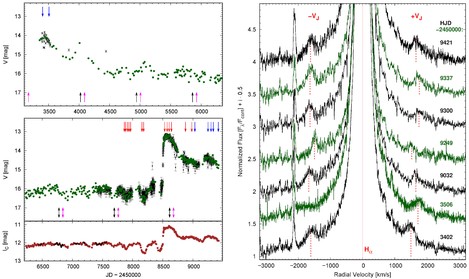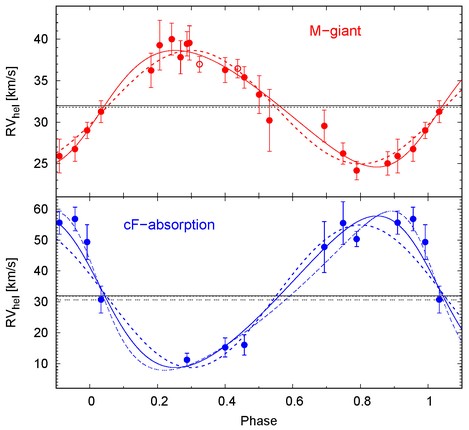
Symbiotic stars are one of the most active classes of binary systems. They are composed of two strongly interacting stars. Even though both of these stars are evolved and with masses similar to the mass of the Sun, each vastly differs in its appearance. One is a cool red giant that is inflated to tens or hundreds of solar radii, while the second star is a hot white dwarf (WD) that is the size of the Earth. Only a handful of these stars – roughly a dozen – were observed to produce collimated jets. The jets in these systems are produced as a result of an outburst of the white dwarf and a succeeding accretion through the accretion disc. Cezary Gałan, Joanna Mikołajewska, Krystian Iłkiewicz, and their collaborators have recently observed one of the jet’s launching symbiotic binaries, St 2-22 (called PN Sa 3-22 in the Simbad database), with the South African Large Telescope (SALT). Thanks to these observations they derived a spectroscopic orbit and complete set of parameters of the components of this system, adding St 2-22 to a rare group of well studied symbiotic stars with jets. Moreover, spectroscopic and photometric monitoring of the system for sixteen years allowed them to detect when the jets ale launched and how they evolve.
In January 2019, St 2-22 showed a sudden, steep brightening by ∆V ~ 2 mag (∆IC ~ 0.7) in ≲ 10 days indicating a new outburst (Figure 1 – left), followed by a slower brightening over a month up to Vmax ≈ 13.2 (ICmax ≈ 11.1), subsequent steady decline and a standstill at V ~ 14.5 (IC ~ 11.7). The most recent observations show that this outburst persists to this day. The previous outburst occurred around 2005. It was reported as relatively short (≲ 200 days). Nevertheless, the onset was not observed then, and its maximum likely occurred during the gap in observations. Consequently, the ongoing outburst could be very similar.
Figure 1 (above): Left: Light curve of St 2-22 with the ongoing outburst. Green and brown dots correspond to the V- and IC -band data, respectively, acquired at the Kleinkaroo Observatory with a 35 cm Meade RCX400 telescope, whereas the ASAS and ASAS-SN V- and g-band, as well as OGLE I-band data, are plotted as black points. Arrows above the light curves mark the SALT/HRS and FEROS observations with (blue) and without (red) jet detection, while those below mark the times of periastron passage (black) and inferior conjunction (magenta).
Right: Evolution of Hα line profile in the high-resolution spectra (HRS and FEROS) of St 2-22 with visible emission components from collimated jets on its wings. The measured positions of their centres after correction on systemic velocity (Vγ) are shown with red dashed lines.
The outburst amplitude, timescale, and spectral evolution resemble those observed in other classical symbiotic stars – the Z And-type outbursts. The blue range of the spectra is dominated by a hot continuum similar to spectra of A–F supergiants, with absorption lines mostly from Ti II, Fe II, and Cr II. These so-called cF-shell absorption lines can be used to measure the radial velocities resulting from the white dwarf orbital motion. On the other hand, the red range of the spectra is dominated by the red giant and traces its motion.
Using both spectral regions allowed for a precise determination of system parameters. The obtained orbital period Psp =918 ±6 days is consistent within 3σ errors with that from the periodic analysis of the light curves. The radial velocities of the cF-absorption lines are in anti-phase with the red giant (Figure 2), and we attribute them to the orbital motion of the white dwarf. The eccentric solution is favored with e = 0.16º ±0.07, and the periastron longitude ω ~ 270º. The semi-amplitudes of the radial velocity curves of both components indicate the mass ratio q = 3.50 ±0.53, mass of the red giant Mg sin3 i = 2.35 ±0.55 Mʘ, mass of the white dwarf MWD sin3 i = 0.67 ±0.15 Mʘ, and the separation of the components a sin i ~ 2.67 AU. The lack of eclipses sets the upper limit for the orbit inclination, i ≲70º, whereas the lower limit i ≳ 52º results from the fact that the white dwarf cannot exceed the Chandrasekhar limit (MWD ≲ 1.4 Mʘ). This indicates a moderately massive white dwarf (MWD≳ 0.8 ±0.2 Mʘ). The red giant mass is then Mg ≳ 2.8 ±0.7Mʘ .

Figure 2: Radial velocity curves of the cool (Top) and hot (Bottom) components folded with the period P = 918 days. The values measured from HRS and FEROS data are shown with filled and open circles, respectively. Lines show synthetic radial velocity curves: for the case of the eccentric orbit (solid), circular orbit (dashed), and from the solution for cF radial velocities only (dot-dashed). The corresponding horizontal lines represent the systemic velocities in these three cases.
Gaia DR3 gives a parallax of π = 0.085 ±0.023 mas, resulting in a value of a distance d ≈ 6.9 kpc, which is consistent with the distance derived from the 2 MASS colors and M5III spectral type and adopting the reddening EB−V = 0.7 ±0.1. The radius of the red giant is estimated to be Rg = 117 ±20 Rʘ which is below filling the tidal lobe even at the periastron.
Figure 1 (right) shows the evolution of the jet components in the Hα line profile. In July 2020 two satellite components with a velocity ~ ±1650 km/s appeared in Hα wings. They are attributed to a launch of bipolar jets. These additional components are present in all subsequent spectra. The approaching component is always roughly two times stronger than the receding one. It has been estimated that the jets are quite strongly collimated (the opening angle φ ~ 10º). The jets are expected to be launched near the white dwarf surface, which would indicate that the binary inclination should be close to the upper limit i ~ 70º.
Both, the outburst behavior and binary parameters of St 2-22 resembles closely the classical symbiotic binary Z And, which makes the two systems look like twins. The most notable difference is the orbital separation, which is slightly larger in the case of St 2-22. In both systems ejection of strongly collimated jets during the late outburst phase was observed. The jet evolution in St 2-22 is similar to the one observed in Z And, where gradual changes within the 200–300 km/s range were observed on a time scale of several months.
The SALT observations of St 2-22 were made under programmes: 2017-1-SCI-046 and 2017-2-SCI-044 (PI: T. Tomov), and 2018-2-SCI-021 and 2019-1-MLT-008 (PI: C. Gałan). Polish participation in SALT is funded by grants MNiSW No. DIR/WK/2016/07 and MEiN No. 2021/WK/01.
Text: Cezary Gałan, Joanna Mikołajewska, and Krystian Iłkiewicz






